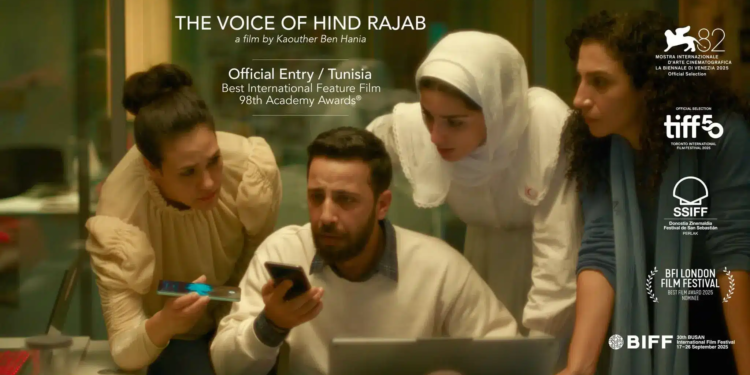Silence after the ovation
Sometimes, silence speaks volumes. This fall at the Venice Film Festival, The Voice of Hind Rajab by Kaouther Ben Hania stunned audiences, earning a nearly twenty-four-minute standing ovation—a festival record. The film tells the story of Hind, a Palestinian girl killed in Gaza in 2024, who pleaded in vain for help while trapped in a car under Israeli gunfire. Yet, as the applause faded, Hollywood’s silence took over. No major U.S. distributor wanted to pick up the film, despite having Brad Pitt, Joaquin Phoenix, and Rooney Mara as executive producers, and being Tunisia’s official entry for the Oscars.
“No one says they’re afraid,” the director confides. “But you can feel the discomfort. Talking about a Palestinian child killed seems like a topic everyone wants to avoid.”
Celebrated films, yet blocked from U.S. screens
Her observation reflects a broader reality. Four films that depict Palestine from 1936 to 2024—All That’s Left of You by Cherien Dabis, Palestine 36 by Annemarie Jacir, The Sea by Shai Carmeli-Pollak, and The Voice of Hind Rajab—are all vying for a spot in the Oscars race. They have been acclaimed at international festivals, moved audiences, and won awards, yet none has broken through the U.S. market barrier.
Anonymous U.S. distributors cite surface-level excuses: crowded schedules, insufficient marketing budgets, or fears that audiences won’t respond. But the truth is clear. It’s not language or quality that blocks these films—it’s their subject matter. In a fragmented Hollywood, where every word about the Middle East can ignite controversy, fear has replaced artistic courage.
Courageous juries versus distributor self-censorship
On the international stage, however, festival juries have judged solely on cinematic merit. The Voice of Hind Rajab earned nine awards at Venice, including the Silver Lion, as well as honors at San Sebastian, Chicago, Ghent, and Hamptons. All That’s Left of You won prizes in San Francisco, Shanghai, Sydney, and Hamptons, while The Sea took home two awards at the Jerusalem Film Festival. These accolades, awarded wherever the films screened, show that critical and artistic recognition is not in question—the obstacle lies in access to the U.S. market.
The ovations and awards demonstrate that where artistic courage persists, audiences and juries know how to recognize and celebrate talent. The question now arises: what will voters in major competitions like the Golden Globes or Oscars do? Will they honor these films and give them the awards they deserve, or will they, too, succumb to the prevailing caution that keeps Palestine silent?
A climate of fear in Hollywood
For the past two years, the Gaza conflict has deepened rifts within the industry. Over 5,000 professionals signed a call to boycott Israeli institutions, while major studios like Paramount and Warner Bros. publicly condemned the initiative, preferring to appear neutral. Between these extremes, a silent majority stays quiet, fearing career or reputational risks. Javier Bardem, wearing a keffiyeh at the Emmy Awards, spoke out against the war, while Amy Schumer took to Instagram to advocate for Israeli hostages. Every gesture sends a political signal.
In this hyper-polarized climate, distributors are on the front lines: buying a film about Palestine risks online attacks or even boycotts. In Hollywood, everything is image—and everything is calculated. Films become sensitive dossiers, “projects to review later,” as if their very existence were problematic.
Audiences are not turning away
Yet audiences remain engaged. Last year, the documentary No Other Land by Yuval Abraham, Basel Adra, and Hamdan Ballal (Oscar 2025 for Best Documentary), which depicts life in a Palestinian community in the West Bank, found no distributor. Its producers self-released the film in U.S. theaters, earning $2.5 million, making it one of the year’s most-watched documentaries. Even more, they turned down an offer from a major platform for ethical reasons, refusing to associate the film with capital tied to the Israeli military industry.
Independent initiatives as a last refuge
Independent efforts have become the final refuge for films deemed “too risky” by major circuits. In 2024, Palestinian-American brothers Hamza and Badi Ali founded Watermelon Pictures in Chicago, providing a platform for Arab and Palestinian-themed films rejected by studios. With model Alana Hadid as artistic director, they have already supported All That’s Left of You and Palestine 36. Both films earned standing ovations and critical praise—yet no offers came from Los Angeles.
“Any time Palestine comes up, the conversation stalls,” says Hamza Ali. “They listen politely, then pass us up to superiors. Nothing moves forward.”
The power of storytelling
Beneath this caution lies a stark truth: in film as elsewhere, the power to tell stories depends on who holds the microphone. More than ever, narrative is central. Controlling the story shapes empathy, defines symbols, and frames collective memory. Blocking a Palestinian story from circulation is also blocking plural perspectives in the public sphere.
Palestinian and Arab filmmakers are not seeking indulgence; they demand the chance to be heard. Each film is a voice, a memory, a humanity. In a world awash with images, denying someone the right to tell their story is denying a piece of their existence. Storytelling is not merely political—it’s the means by which lives meet other lives.
When other voices rise elsewhere
If Hollywood, out of fear, chooses silence, other actors—festivals, independent distributors, artist collectives—work to reopen the spaces the industry locks. These initiatives remind us that cinema is not just a product to sell, but a universal language capable of crossing borders others wish to erect. At the last Venice Film Festival, the Venise4Palestine collective amplified this collective voice, ensuring Palestine is not confined to the margins of global storytelling. Bringing together filmmakers, technicians, and artists from across the world, they occupied the festival’s public spaces—through screenings, marches, and symbolic interventions—highlighting that cinema, beyond being a market, is a place of memory and resistance.
These modest acts carry immense weight. They show that film can still be an act of courage, a way to exist in a world dominated by stories that exclude. Unlike Hollywood’s silence, these voices affirm that to tell a story is already to act. Cinema, in its most essential form, is a tool of connection and transmission: it builds shared memory, fosters empathy, and inscribes into history those who might otherwise be erased. The question is not who holds the truth, but whether everyone can share their voice. Cinema’s universality lies in this: its ability to make invisible worlds visible, to offer a common space to long-suppressed stories, and to remind us that every image, before being political, is a right to exist.








